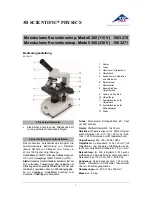
©
Home Training Tools Ltd. 2012
Page 6 of 8
Visit www.homesciencetools.com
Diopter
adjustment
Locking screw
1.
Lower the stage using the coarse focus
knob.
2.
Raise the Abbe condenser to the upright
position by turning the condenser knob.
Open the iris diaphragm by pulling it toward
you (when facing the stage).
3.
Place one drop of high quality immersion oil
(our item MI-IMMOIL) on top of the
coverslip. (In some cases, it may be
beneficial to place a drop of oil between the
condenser and the slide also, but this is
usually not necessary for most applications.)
4.
Move the 100x objective lens until it clicks
into position, and then slowly move the
stage up until the lens makes contact with
the oil.
5.
Continue focusing with the coarse knob until
the color or blurred outline of the specimen
appears. Finish focusing with the fine focus
knob. Adjust the condenser and diaphragm
until you see the specimen in clear, sharp
contrast.
6.
When you are done, clean all the oil off the
lenses and slides using lens paper and lens
cleaning solution (instructions are on page 2
of this manual).
Using Filters
The Professional Laboratory microscopes
come with blue, green, and
yellow filters that can be
placed in the filter holder
located below the iris
diaphragm. Use the following
procedure to insert the filter:
1.
Underneath the iris diaphragm there is a
small filter holder knob. Use this to swing the
filter holder out from under the diaphragm.
2.
Place the filter in the holder, and swing back
into place.
3.
Adjust focus and diaphragm normally.
MI-6000TRI Model
Trinocular Head
The MI-6000TRI
model comes with a
trinocular teaching head.
With its comfort-viewing
30° inclined binocular
eyepieces and a vertical
eyepiece, it is ideal for
simultaneous viewing or
digital camera photography. The vertical
eyepiece is equipped with a diopter, as are the
binocular eyepieces, which are described on
page 3. Adjustments will vary among different
users.
1.
Have inclined eyepiece user focus the
microscope.
2.
Have the vertical eyepiece user rotate the
diopter adjustment (the knurled band) until
the specimen is also in focus for his or her
eyes.
MI-6000DHD Model
The MI-6000DHD model comes with one
inclined eyepiece and a vertical eyepiece with
diopter, which allows simultaneous viewing or
digital camera photography.
Dual Teaching Head
Adjust the vertical eyepiece according to the
trinocular instructions above. Or, follow the
digital camera instructions below.
Adding a Digital Camera
While a digital camera can be used with the
other models, it works especially well with the
dual teaching head and trinocular head.
A digital eyepiece package (our item MI-
DCT5000) will include a digital camera eyepiece
to replace your microscope’s vertical eyepiece.
To remove the eyepiece, loosen the tiny screw
until you can lift the eyepiece out (you will not
need to completely unscrew it).
MI-6000STD Model
The MI-6000STD model features a 360º-
rotating head with a monocular eyepiece.
Maintenance
Changing the Bulb
Your microscope halogen bulb should last
for years of normal use. Follow these steps for
replacing it:
1.
Obtain the correct 20-watt halogen
replacement bulb (our item MI-BULB7).
2.
Unplug your microscope and allow it to cool
before replacing the
bulb.
3.
Lay the microscope on
its side to access the
bottom.


























